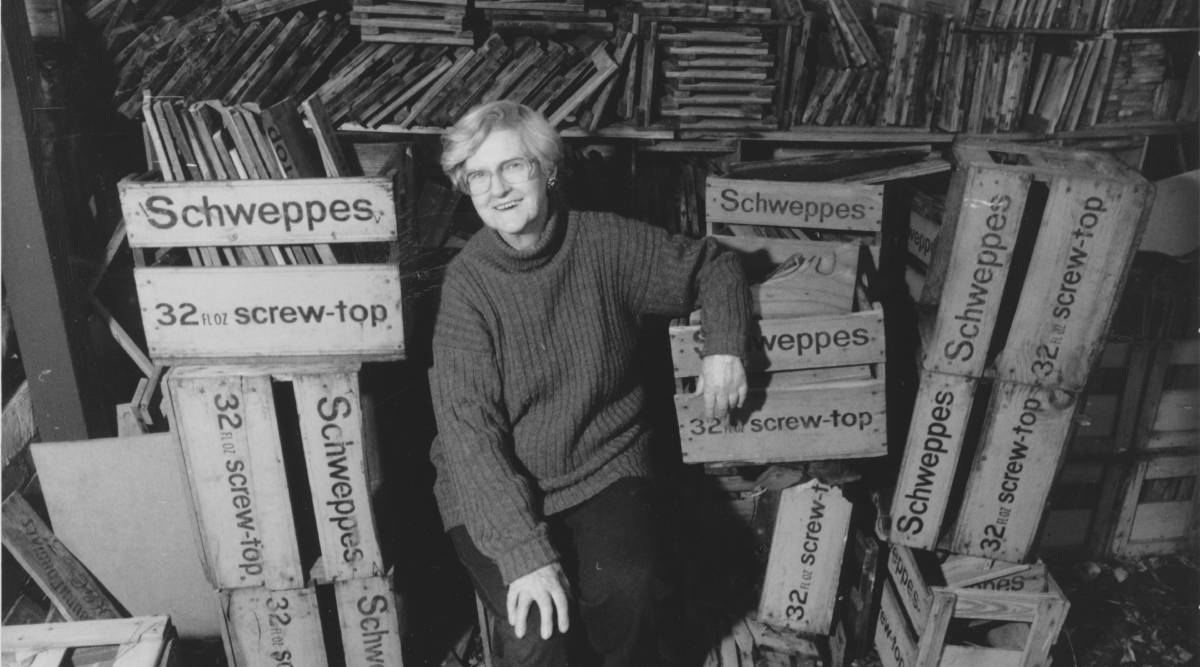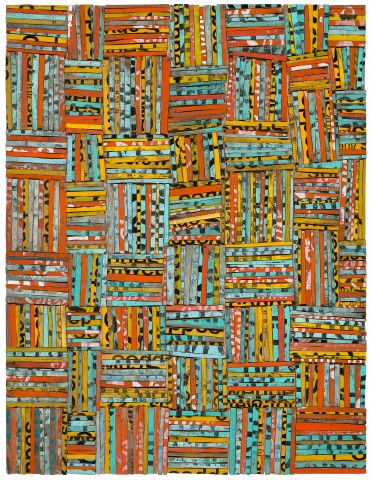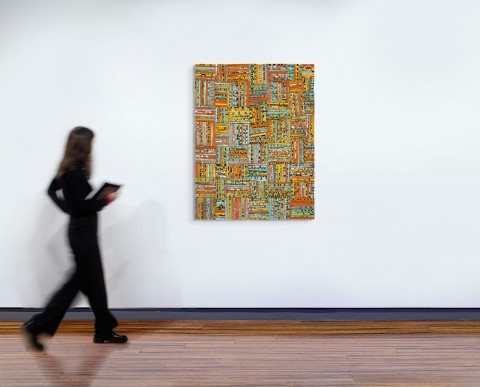ALL THAT JAZZ, 1989
ROSALIE GASCOIGNE
sawn and split soft drink crates on plywood
131.0 x 100.0 cm
signed, dated and inscribed with title verso: ALL THAT JAZZ / 1989 / Rosalie Gascoigne
Roslyn Oxley9 Gallery, Sydney
Private collection, Melbourne
Martin Browne Fine Art, Sydney
Private collection, Sydney
Deutscher~Menzies, Sydney, 15 March 2006, lot 21
Private collection, Melbourne
What Is Contemporary Art?, Rooseum, Malmö, Sweden, 3 June – 30 July 1989 (illus. in exhibition catalogue, p. 48)
Rosalie Gascoigne, Roslyn Oxley9 Gallery, Sydney, 1 – 18 November 1989, cat. 6 (label attached verso)
20th Century Australian and New Zealand Paintings, Martin Browne Fine Art, Sydney, 22 August – 28 September 1991, cat. 77 (illus. in exhibition catalogue)
Rosalie Gascoigne: Plain Air, City Gallery Wellington, New Zealand, 22 February – 16 May 2004, cat. 14
Rosalie Gascoigne, National Gallery of Victoria, Melbourne, 19 December 2008 – 15 March 2009, cat. 47
Allen, C., ‘Bill Robinson: Rosalie Gascoigne’, Art Monthly Australia, no. 27, December 1989, p. 19
Delaruelle, J., ‘Free of gobbledegook’, Sydney Review, Sydney, December 1989, p. 16
Johnson, A., ‘Rosalie Gascoigne’, Art & Text, no. 36, May 1990, p. 151 (illus.)
McDonald, E., ‘“There are only lovers and others …” An interview with Rosalie Gascoigne’, Antic, Auckland, no. 8, December 1990, p. 13 (illus.)
Drury, N., Images in Contemporary Australian Painting, Craftsman House, Sydney, 1992, pl. 162, pp. 176 (illus.), 177, 257
Macdonald, V., Rosalie Gascoigne, Regaro, Sydney, 1998, pl. 7, pp. 45 (illus.), 112
Gascoigne, M., ‘No ordinary woman’, Alumni News, University of Auckland, vol. 12, no. 1, 2002, cover (illus.), p. 2
Rosalie Gascoigne: Plain Air, City Gallery Wellington and Victoria University Press, Wellington, 2004, pl. 18, p. 68 (illus.)
McAloon, W., ‘Roadrunner’, New Zealand Listener, vol. 193, no. 3336, 17 – 23 April 2004
Armstrong, C., 'Collector profile: Pat Corrigan AM', Art and Australia, vol. 43, no. 3, Autumn 2006, p. 450 (illus., installation view)
Dedman, R., ‘Rosalie Gascoigne’, Australian Art Market Report, issue 24, Winter 2007, p. 24 (illus.)
Grant, J., ‘Set the letters free’, Eye: The International Review of Graphic Design, no. 64, 2007, p. 29 (illus.)
Gellatly, K., Rosalie Gascoigne, National Gallery of Victoria, Melbourne, 2008, pp. 21, 100 (illus.), 135
Gascoigne, M., Rosalie Gascoigne: A Catalogue Raisonné, Australian National University Press, Canberra, 2019, cat. 345, pp. 236 (illus.), 332, 350 – 351, 353, 370
‘Gascoigne’s art communicates a fervent commitment to life. She flourished from middle into old age, while her peers underwent the more usual passage to resignation and calm wisdom. Most people accept the weakening. Rosalie, growing older, sharpened herself. Her art affirmed the sap of life within weathered forms.’1
HIGH RES GASCOIGNE MONARO copy.jpg

Rosalie Gascoigne first discovered wooden soft drink crates in 1978 at the Schweppes depot in Queanbeyan, NSW, near Canberra, gathering them up and taking them home with no predetermined sense as to how they would be used in her art. They first appeared in their full, unadorned form in the twenty-piece work, March Past, 1978 – 79 (National Gallery of Australia); its rows of alternating horizontal boards of red, green and faded natural wood inspired by the Anzac Day March she had recently witnessed on a trip to Melbourne.2 Gascoigne was hooked. From that serendipitous moment she was to use the material across her oeuvre in around 130 works, even returning to her precious stockpile in 1999, the last year of her life, after transition of the manufacture of the crates to plastic had seen them become an increasingly rare resource.3 As the artist’s husband, astronomer Ben Gascoigne recalled, Gascoigne’s capacity for collecting this material en masse was considerable, and it served her well:
‘It could be disconcerting, returning home after a day at the office, to find the drive blocked by a couple of hundred soft drink crates. They had to be sorted, stacked, cleaned and dismantled, the latter process involving pulling out up to forty nails from each box, with no short cuts. The family helped, but she did most of the work herself.’4
Rosalie Gascoigne (Richard Briggs).jpg

Initially, Gascoigne combined the beautiful, weathered woods and colours of the planks of drink crates in elegant compositions that lyrically evoked the Australian bush. The typography of various printed brands on these crates – Dales, Tarax, Crystal, Swing – is used to great effect, dancing across the surfaces of works as if mirroring the experience of dappled light and of the changing seasons on the landscape. However, once this preoccupation had run its course, she began to split the boards – first with a tomahawk, and then, a bandsaw – often manipulating the graphic black lettering of her much-loved yellow Schweppes crates into tightly compacted groupings which made the fragmented letters seem to jostle, bounce or rustle across the picture plane.
Notably, All That Jazz, 1989 was shown in the artist’s groundbreaking exhibition at Roslyn Oxley9 Gallery, Sydney in November 1989. Gascoigne’s first solo exhibition in Sydney since her Gallery A début in 1976, this landmark exhibition brought together major soft drink crate works such as Monaro, 1988 – 89 (Art Gallery of Western Australia); Wheat Belt, 1989 (National Gallery of Australia); and Outback, 1988, with a significant group of retro-reflective road sign works in her signature yellow and orange.
As we see in the majestic All That Jazz, 1989, this way of working with the slithers of boards also coalesced with Gascoigne’s use of the grid as an important organising principle within her work. Closely aligned to Modernist art practice, the tessellation, compression and repetition that occurs across the work’s structure, no longer evokes feelings or sensations related to the natural world, but instead suggests, in the self-conscious regulation of its surface, a sense of continuum and endlessness that is in and of the work itself. Calling to mind an elaborate and highly coloured patchwork quilt (particularly the geometric creations of the Gee’s Bend quilters of America’s Deep South), the knowing combination of the work’s title and form brings a sense of musicality and lively movement to the piece. As Mary Eagle has observed:
‘…[A] work by Gascoigne gains aesthetic impact by virtue of how an underlying grid or cell-like structure serves as a ground for deviations – of wave after wave, mirroring, reorientation, transposition, positive-negative inversion, counter-balance, swivelling and, in the text panels, a play of words.’5
Like all the artist’s work, the creation of All That Jazz was a haptic rather than predetermined experience. Gascoigne was opposed to the idea of planning, and didn’t draw, use collage, or experiment with compositional ideas before commencing a piece. As the artist’s son, Martin Gascoigne has noted, her approach was ‘visual and practical, not conceptual’, and she let her materials ‘take her by the arm’.6 By glueing the slithers of wood to a plywood backing board and working in small component parts, Gascoigne could shuffle the pieces until they settled in place and felt ‘right’. As she remarked,
‘I can’t do anything except I can see and I can arrange… but mostly I can arrange …I can do something that feels like something but I can’t do anything that looks like something.’7
Before beginning, there was no sense as to scale or if the work was single or multi-panelled, horizontal or vertical. This was determined in the making, and in the time sitting with and studying the piece after its completion. This was also the stage at which it was given a title – the title the work seemed to demand for itself.
1. Eagle, M., ‘Rosalie Gascoigne: Artist and Sculptor’, The Age, 1 November 1999
2. Rosalie Gascoigne, cited in Gascoigne, M., Rosalie Gascoigne: A Catalogue Raisonné, Australian National University Press, Canberra, 2019, p. 187. March Past, 1978 – 79 was first exhibited in the artist’s solo exhibition at Ray Hughes Gallery, Sydney in 1979
3. ibid., pp. 71, 78, 120. The last work Gascoigne made with soft drink crates was Great Blond Paddocks, 1998 – 99. In his catalogue raisonné, Martin Gascoigne gives two different totals, saying Gascoigne made around 127 works from soft drink crates (p. 71) as well as around 130 (p. 120)
4. Gascoigne, S.C.B., ‘The Artist-In-Residence’ in Eagle, M. (ed.), From the Studio of Rosalie Gascoigne, The Australian National University Drill Hall Gallery, Canberra, 2000, p. 12
5. Eagle, M., 'Rosalie Gascoigne’s Lyrical Derailments' in Seear, L. & Ewington, J. (eds.), Brought to Light II: Contemporary Australian Art 1966 – 2006, Queensland Art Gallery, Brisbane, 2007, p. 200
6. Gascoigne, M., op. cit., p. 70
7. Rosalie Gascoigne, cited in Peter Ross, ‘Interview with Rosalie Gascoigne (transcript)’, Review, ABC TV, broadcast 12 August 1990.
KELLY GELLATLY

